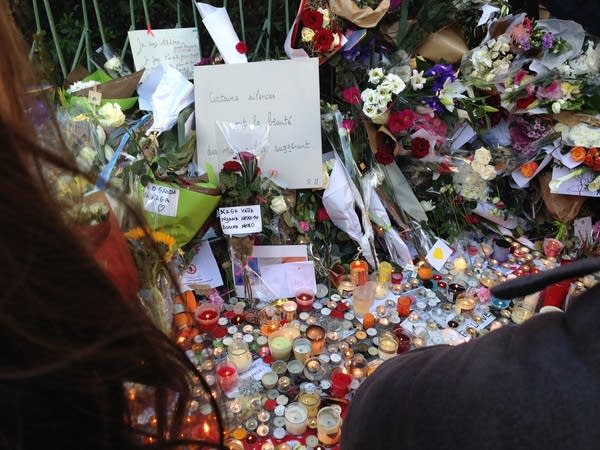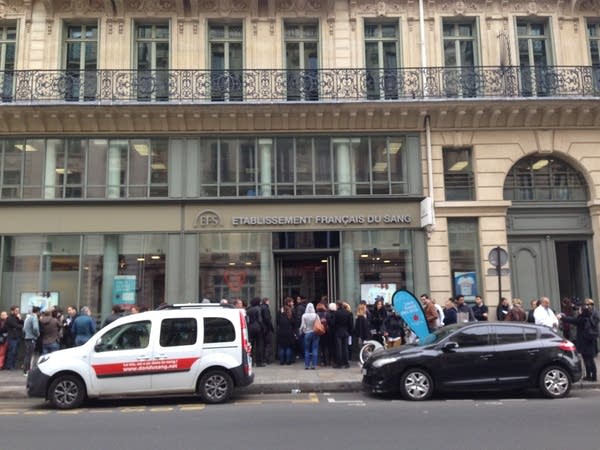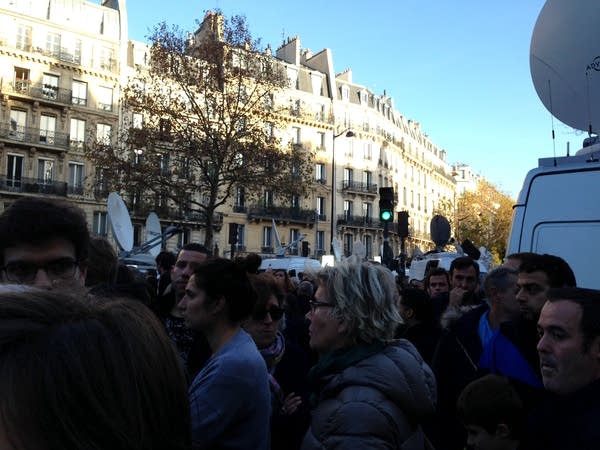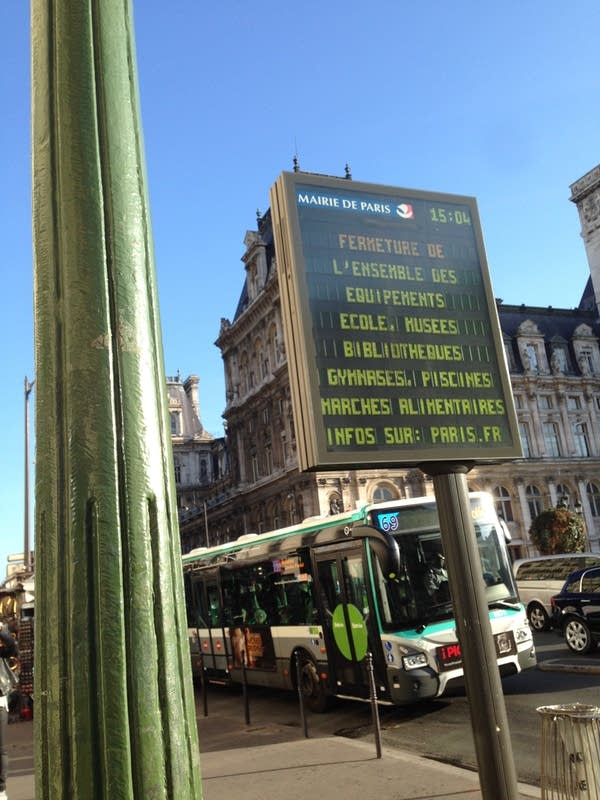Paris: What I saw in the three days after the attacks

November 17, 2015
Hailey Colwell wrote for our Local Current blog as a college contributor when she was attending the University of Minnesota—Twin Cities. She graduated this spring, and this fall she's been living in Paris. This post is republished, with permission, from her blog Des mots // du monde.
We had spent the night in a trance-like state, going between watching TV reports and answering messages from friends and family members trying to reach us from across the globe. Barely speaking, our eyes went from iPhone to television screen as locations surfaced and numbers rose. We spent the morning doing the same thing. Then at noon on Saturday, my cousin, Maggie, and I left my apartment and opened the courtyard door into the sullen streets of Paris.
On Friday, Nov. 13 around 10 p.m., news broke of coordinated terrorist attacks at six sites in eastern Paris. A team of attackers opened fire on restaurants, in streets, and at the Bataclan concert hall, where they trapped more than 100 hostages. At Stade de France on the edge of the city, explosions from suicide bombers sparked terror and confusion. Now, 72 hours later, the death toll hovers around 130 and more than 300 people are wounded. France has launched a country-spanning search for the attackers and an airstrike in Syria.
I do not know how to connect those terrible numbers and facts with why I am writing this post. I am not even going to try. I just want to share a little of what I saw in the three days that followed in hopes that it might bring you a little bit closer to Paris, and myself closer to wrapping my head around it.

Première journée
The city had been told to stay inside on Saturday, Nov. 14. But my cousin and I were definitely not the only ones out that afternoon as we crossed Parc Monceau and the Batignolles neighborhood.
There was someone on every street, though the emptiness in the neighborhood was all too apparent. What struck us more was the silence. Everyone walked with soft footsteps and spoke in hushed voices. They moved gingerly, but they moved. In the park, a few runners jogged around the perimeter. A couple of children walked with parents who had chosen to take their families out today; to make sure they felt safe on the streets of the city they live in.
My cousin and I headed east from my neighborhood in the 8th arrondissement, where I have been living and working as an au pair since flying here from Minnesota in September. We walked to Montmartre, where we climbed the hill to the Sacré-Cœur Basilica, the only place she knew she wanted to visit. On this strange, still day, we played tourists in a country we are calling home for a temporary time, in a city I have been trying to learn the ins and outs of these past two months. We were two of many looking to get outside and see the sights.
Maggie had arrived at my apartment around 10 p.m. the night before, just as the news started to break. She had no problem taking the métro from Orly airport, though we feared that if she had been much later she might have run into problems when a few of the lines closed. We stayed above ground today, and far above it as we looked over the city from the basilica.
The crowd was not massive, but it was a crowd. At Place du Tertre, a long stream of Parisians wandered up from the stairways, taking pictures of street art and milling about the market, going to sit at one of the cafés or buy treats from the pastry shop. They were doing Saturday things, even if it was not anything like a normal Saturday.
By the Moulin Rouge, the intersections were packed as normal. At Anvers, shoppers dug through piles of cloth, trying to find the best and the cheapest. Across the street at a playground, families let their kids get some fresh air.
Going down the hill and into the 9th arrondissement, we passed by the Etablissement Français du Sang, where people were lined up on the sidewalk waiting to give blood.

We crossed into the most touristy part of the city. In the Louvre’s courtyard, people stood on blocks, taking pictures with their hands raised on one side to make it look like they were holding the giant pyramid by two fingers. The Jardin des Tuileries was barren in the gray light, people crossing it but few bothering to sit down. It was getting colder. A little bit of rain fell.
We crossed the river toward Boulevard Saint-Germain. At the famous intersection where Les Deux Magots and Le Café de Flore border Saint-Germain-des-Prés, people filled the sidewalk chairs as usual. A girl cried in a doorway, her face blocked by her group of friends.
At Église Saint-Sulpice, we caught a bus to take us home. It skirted its normal route through Place de la Concorde and instead cut through the busy Champs Élysées, and we watched the Arc de Triomphe get bigger in front of us before the bus turned off of the avenue.
Maggie and I climbed the stairs to my room to watch the news and check our phones as we sat under a blanket. She told me that seeing so many renowned places at once doesn't feel real. Doesn't feel real is a term we threw around a lot during our nine-mile walk. It felt good to get out, but I was sorry to have forced so much into it. And was right — we felt like we were sleep-walking. I'm sure others did too.
At night, eating dinner at Le Poncelet in my neighborhood, police cars and ambulances drove by a few times. Everyone paused their conversations, looking up the street. They’re going east, we all noticed.
We lingered a bit, but it was almost 11 and the place was closing. We walked home.

Deuxième journée
The next morning, I walked Maggie to Étoile Square right next to the Arc de Triomphe so she could catch a bus to the airport. She had no problem getting through security and back to the southern French town where she is studying.
I walked down Avenue Mac Mahon toward Rue Poncelet. I did not realize it would bring me to the street market my host family likes to visit during the weekend. It was full of people, and against the morning’s sunny backdrop the atmosphere seemed cheerful enough. Shopkeepers made jokes and kids jumped around as they followed their parents past fruit stands. A violinist played a melancholy piece a little ways away from the market. A woman in running pants took her phone out and stood across the street filming him for a long time. I bought lettuce and headed back toward Parc Monceau.
Unable to sit inside for too long, I put on my running clothes and jogged to the park’s perimeter. Passing through the black metal gate, I joined the train of joggers that can be found at the park on any Sunday. Some padded along slowly in groups, keeping up conversations. A woman in front of me slowed and stopped when she saw someone she knows, pausing to kiss her on both cheeks before finding her pace again.
A lot of people went fast, lap after lap of adrenaline, happy to sweat and to be outside and to move. Running makes you feel alive.
I ran six and a half laps around the 1-kilometer loop, curious enough to measure how long it would take to run to the area where everything happened. It reassured me that it took about 40 minutes.
I returned to a text from my friend: she and some other girls were going to visit the Bataclan memorial site. I decided to go with.

Une rue plein de gens
Châtelet is one of the busiest métro stations and sits at the center of Paris. When my two au pair friends and I walked through its wide tunnels, our steps echoed. The place was much more deserted than normal.
“My family told me not to take the métro,” one friend says. She did not tell them where she was going; just that she needed to get some air.
We got out at Odéon and met up with other friends. We walked through the Marais, in the 3rd arrondissement. People were everywhere, eating, walking. The sidewalks were full. A little girls sat whining on the sidewalk as her family stood patiently ahead, giving her some tough love.
We wondered if the sidewalks were so full because of traffic to and from the Bataclan. I thought people were just out, doing something with their Sunday, with their families and friends.
But the area around the concert hall was crowded for other reasons. When we reached Boulevard Voltaire, the street was full of reporters and people trying to get close to the police barriers around the building. Many took pictures. At the edge of the tree-lined boulevard, people carried small candles through the crowd, shielding the flames in their hands and saying “pardon,” as they pushed gently through to the front. Kneeling down, they added their candles to the collage of colorful wax circles, kids drawings, flowers and handwritten messages.
Along the fenced side of the boulevard, people went up to the railing and took pictures of the Bataclan, the colorful building deserted and quiet on the obstructed side of the street.
Later on, in my French class on Monday, my friend told me she had been thinking of going to the concert — she loves the Eagles of Death Metal. Two other au pairs I know happened to be outside of the theater when the shooting started. Another was visiting her friend who lived across the street and spent the night in her apartment listening to people screaming.
Thankfully, none of these friends were physically hurt. But they are afraid to walk through Paris, and they have nightmares about blood on the street. They are looking for professionals to talk to here and answering messages from their families in the States asking whether they are coming home.
En courant
We walked away from Boulevard Voltaire toward Canal Saint-Martin and along the Seine. We sat along the curved bank behind the Notre-Dame Cathedral and watched it start to glow as the light faded. The sky looked paint-brushed with a few squiggly wisps from planes. The crescent moon made it look even more like a painting. Shadowy forms moved up and down the banks — people were still out walking, sipping beers and smoking cigars by the water. People our age, jeunes, as the French would say, huddled in groups. A quarter after six, we crossed back onto the island toward the cathedral and into a new crowd.
The hordes of people standing outside of Notre-Dame were alert and still. We found a spot near a corner of the church. Police patroled an open area at the front where officials were pulling up to join the cathedral's mass for families and survivors of the attacks. People shouted “boo” when someone got out. My friend (and I) wondered whether it was the president.

We walked away from the gridlocked crowd and off of the island. We turned, but a woman told us not to go that way. We headed in another direction, trying to get to my friend’s apartment. A group of boys ran down an alley past us. Other people were suddenly running too. We thought we heard someone say, c’est une blague, it’s a joke. But we felt the urge to run too. We walked quickly up the sloping Latin Quarter streets.
We later heard about the false alarms that happened that night — mainly someone setting off fireworks in Place de la République. We wondered whether the runners we saw were running from something else.
A bit farther, though, and we reached some windy old streets lit with twinkling lights for the holidays. People sat at bars, strolled, and bought crêpes with ham and egg cooked into them. We started strolling again, and the mood felt reassured.

Troisième journée
For the people of Paris, life goes on. Even if people still talk in hushed voices. Even if heads turn when a siren goes off and people cast side-glances at each other as they walk down the street. Parisians are going about their lives, not as if nothing has happened, but because this has happened, and they want to go on despite it.
The métro train I was on yesterday stopped in the dark tunnel on my way to class. For 30 seconds, I felt the other passengers holding their breath, shifting in their seats, breathing out when the train started to move again. But an escalator up to street level brought everyday life rushing back, with cars and pedestrians hustling around the busy square, getting to where they need to go.
I picked up the girl I babysit at school and we walked home for lunch. She knew about what happened, but she smiled and skipped like normal. As we often do, we spent some time singing. Today’s melody was, “the sun will come out tomorrow,” our two accents somehow hitting the same notes. Later on, a bit of a song I can't name gets stuck in our heads. We sing the one line we know over and over again, in French: gardons espoir. It means, "let's hold onto our hope."

